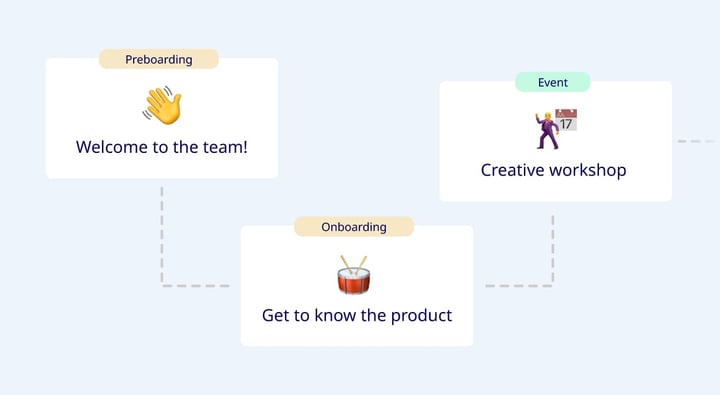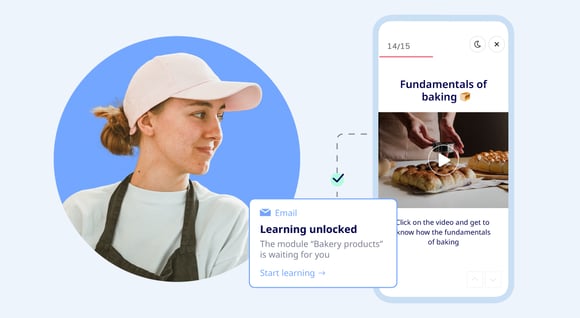Experiences and emotions are in focus when a new hire arrives on the first day. Expectations and dreams have to be fulfilled both for the new hire and the company. We have collected a few good onboarding tips to help you create a better onboarding experience for your new hires.
Overview (Jump to a specific onboarding tip by clicking on the headline):
Tip no. 1: The first 90 days are essential
Tip no. 2: Structure gives better results
Tip no 3: Ignite the engagement with a mentor program
Tip no. 4: Get the new hire set up from home
Take a quick test 👇 (Psst...all answers can be found on this page)
Get more tips on onboarding here: Everything you need to know about onboarding
Onboarding Tip No. 1: The First 90 Days are Essential for Success
When new hires experience a high level of service from colleagues and leadership within the first 90 days, they will typically have a more positive attitude towards the new job, be more engaged, and increase their work effort. This was shown in a study based on 294 new hires (Source: Academy of Management, 2012)
The same study also showed that if the new hire did not get answers to his/her questions or did not get referred to someone he/she could ask, the level of dissatisfaction would increase, and the new hire would become unproductive - and worst case: be out the door after 3-4 months.
So, a good rule of thumb for: Plan the first 90 days for your new hire well for a successful onboarding program.
Are you Committing this Classic Onboarding Mistake?
Some companies have an onboarding program for new employees and therefore believe that everything is fine. But we need to remember that onboarding is more than just formal training. Michael Falcon from the Experience Academy says that onboarding is:
“The design of what your new employees feel, see and hear after they have been hired.”
In other words, we need to ensure that the onboarding program includes colleagues, business partners, and the leadership to make sure that everyone is aiding the process of creating a good onboarding experience for the new hire.
Tip no. 2: Structure Gives Better Results
 Seeing 2, 3 or 5 years as successful retention rates depends on the industry and the type of job. No matter what's normal in your field, retention can be increased by having a structured onboarding program in place.
Seeing 2, 3 or 5 years as successful retention rates depends on the industry and the type of job. No matter what's normal in your field, retention can be increased by having a structured onboarding program in place.
A study from Wynhurst Group showed that a structured onboarding increases the chance of retaining new hires for more than 3 years by up to 58%.
Having a structured onboarding tells the new hire: You are important to the company. A structured onboarding program signals that a company has thought everything through and that they are ready to receive a new hire with open arms.
Make Sure the New Hire Feels that They Have Been Seen, Heard, and Feels Responsible
If your organization does not use an HRM or LMS platform, you can still create a structured onboarding program using your calendar system, a spreadsheet, or print it out physically.
But structure is not everything. As a leader, you can make an enormous difference if you often make sure to contact your new hire to show them that you appreciate them.
This will make the new hire feel that they are being seen, heard, and feels responsible. Actually, this is also a pretty good idea when it comes to saying goodbye to employees that leave, known as the offboarding stage.
What to Have in Your Structured Onboarding Program?
There are a lot of things that should be covered in the onboarding program. Here are some suggestions that are good to structure:
- Technology and Software
- Tools (resources such as computers, phones, software etc)
- Work processes
- Key people
- Products
- Customers
This is not an extensive list. There are things that are best taught in other ways than through formal training. An example could be your company values.
Tip no. 3: Ignite the Engagement with a Mentor Program
 Even though it can be a bit of a communicative challenge, it is essential that your new hires are introduced to your company values in your onboarding program. As humans, we are programmed to perform better when we are able to connect the meaning of what we do and why we do it. We want to know what we are fighting for.
Even though it can be a bit of a communicative challenge, it is essential that your new hires are introduced to your company values in your onboarding program. As humans, we are programmed to perform better when we are able to connect the meaning of what we do and why we do it. We want to know what we are fighting for.
In this situation, a mentor program, or "buddy" program, can be a good idea. Assigning a mentor will help your new hire understand the company culture and enrich the employee experience.
A mentor (or buddy, whatever you'd like to call them) is also able to support your videos, presentation materials, and staff handbook with a more vivid perspective on the company values. The mentor program does not have to be difficult or expensive to create but will boost your new hire to become a happy team member.
Steer Clear of Overexploitation and Optimize Everyone's Time
You can choose one mentor, or you can bring in people from different departments or levels in the organization by planning short appointments in their calendars. That way, a new hire can formally meet the key people they will be working with. These appointments need to be short and concise.
By facilitating the meetings and putting structure to the mentor program, you avoid overexploitation of colleagues and optimize everyone's time in the onboarding process.
Tip no. 4: Get the New Hire Set Up From Home
 Onboarding takes time for the organization and the new hire. And it is very important to use time effectively. It is about finding the balance that adds optimal value to the organization as a whole. In some cases, e-learning can be enough.
Onboarding takes time for the organization and the new hire. And it is very important to use time effectively. It is about finding the balance that adds optimal value to the organization as a whole. In some cases, e-learning can be enough.
Spend the time efficiently and give your new hires a digital preboarding already from home. This way, you save time AND can kick-start the sense of belonging even before your new hire had their first day.

